Invertebrate Lab
People in the Lab
Director
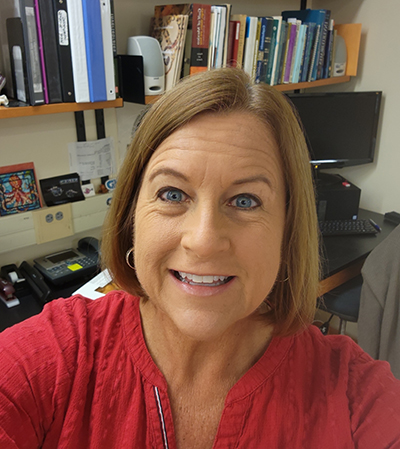
Dr. Heather Judkins, Ph.D.
Dr. Heather Judkins is a full professor in the Department of Integrative Biology at the University of South Florida St. Petersburg. She received a Bachelors degree in Marine Affairs from the University of Rhode Island, Masters degree in Science Education from Nova Southeastern University and her PhD in Biological Oceanography from the University of South Florida. Her research focuses on understanding the evolution, ecology, and biogeography of cephalopods with a main focus currently in the Wider Caribbean.
Current Students
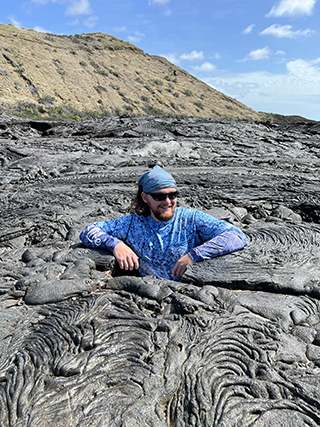
Christian Goldman
Christian began his research on the health of artificial oyster reefs in Tampa Bay in spring of 2025. To achieve this, he will frequently measure water quality parameters, oyster recruitment, and the prevalence of Perkinsus marinus. This protozoan parasite poses a common threat to oyster reefs along Florida's Atlantic and Gulf coasts. By analyzing its abundance in relation to other environmental factors, he aims to gain insight into the parasite's behavior and its potential impact on the reefs. Through this research, Christian aims to contribute to the understanding of artificial oyster reefs and the ecological benefits they provide to estuarine systems, aiding conservation biologists in their efforts to protect and restore these vital habitats.
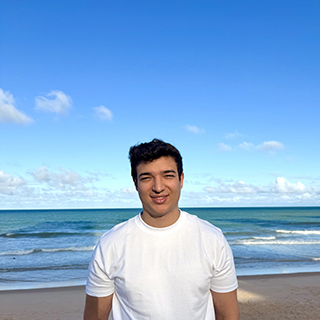
Research
My project examines the role of conditioned microplastics in redistributing microbes within marine ecosystems. By studying how these plastics, coated with microbial biofilms, interact with human-associated microbes from sources like wastewater and stormwater, I aim to understand their potential impacts on filter-feeders and energy dynamics in marine environments. This research will contribute to our understanding of microplastic pollution and its broader ecological consequences, particularly in the Tampa Bay region.
Lucas Abreu, Graduate Student
Hi, I’m Lucas and I’m a first-year master’s student in the USFSP Conservation Biology program! I earned my bachelor’s degree in Biology with a concentration in Biomedical Sciences, where I developed a strong interest in the connections between marine ecosystems and human health. Before joining grad school, I worked as a Lab Prep Assistant at the University of South Florida, where I gained valuable experience in microbiological media preparation, lab operations, and instructional support. This role enhanced my technical skills and deepened my understanding of biological processes, which further motivated me to pursue advanced research in conservation biology. I’m now excited to be working with Dr. Heather Judkins and Dr. Larry Dishaw to explore the intersections of marine biology and biomedical sciences. As an international student from Brazil, I’m excited to dive deeper into my studies and contribute to impactful research here at USFSP.
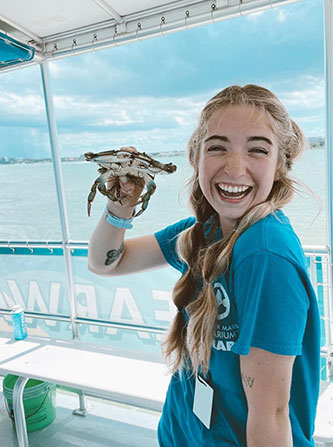
Jordan Dilena, Graduate Student
Hi, I’m Jordan and I’m a first-year master’s student in the USFSP Conservation Biology program! As a Florida native, I have always had a passion for conservation and marine biology which led me to study marine biology for my undergraduate career. My undergraduate institution gave me the invert bug and a passion for marine invertebrate research involving microplastics. Upon graduating with my B.S. in Marine Biology from The University of West Florida, I took a two-year gap where I had the opportunity to work as a marine biologist for Clearwater Marine Aquarium and a scientist for Tampa Bay Aquatic Preserves. These opportunities gave me invaluable skills and solidified my want to pursue a master's degree in conservation biology. I am thrilled to be here in the Judkins invertebrate lab and look forward to diving in head first to my thesis project.
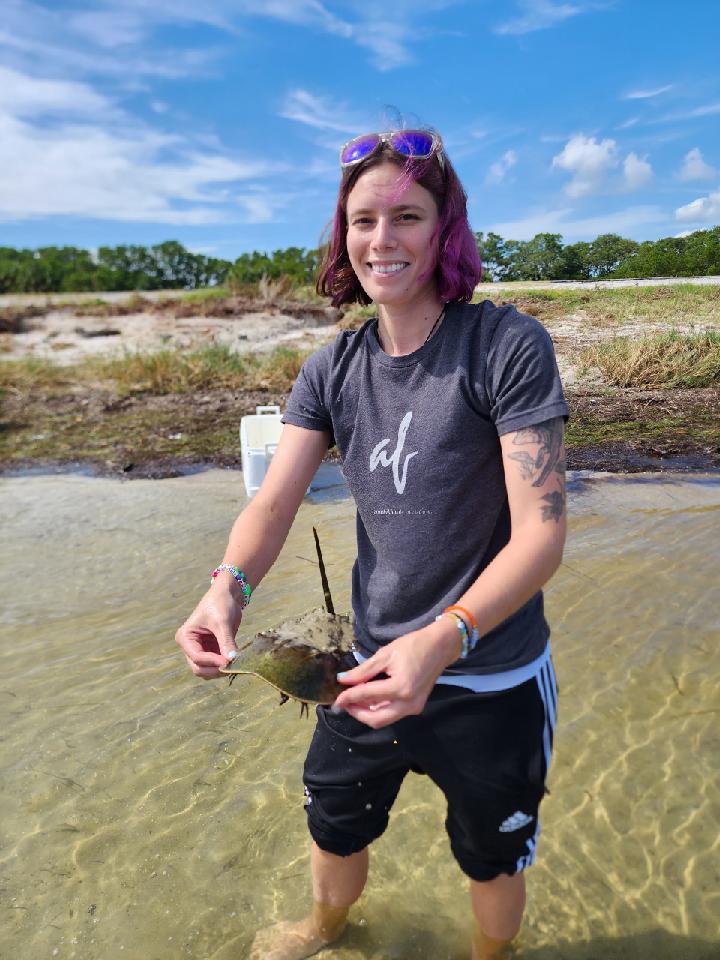
Research
I study Atlantic horseshoe crabs, Limulus polyphemus, and the effect of blood volume reduction on their physiological behavior. This project reflects the blood harvesting that occurs to hundreds of thousands to over a million specimens per year for biomedical testing. This study aims to provide valuable insights into the sustainability of this practice and its potential impact on horseshoe crab populations.
Marty Sims, Graduate Student
Hi, my name is Marty Sims. I am a first year master’s student at the University of South Florida, in the College of Marine Science. I work in Dr. Heather Judkins marine invertebrate lab, studying ecosystem modeling of pteropods found within the pelagic region of the Gulf of Mexico via acoustic detection. I came to USF after working several years in the medical field and deciding it was time to go back to school to study what I truly desired - the ocean and all its wonderful mysteries! So, I took interest in this lab while researching graduate advisors who work with marine invertebrates, namely cephalopods. That is when I found Dr. Judkins and strongly desired to work with her, especially after seeing all the breakthrough research going on in her lab, as well as the impressive adjacent projects taking place at USF’s College of Marine Science. Living in St. Pete has been a wonderful experience so far, full of great marine science resources, beautiful destinations, and great culture, and I can’t wait to discover more while pursuing my degree!
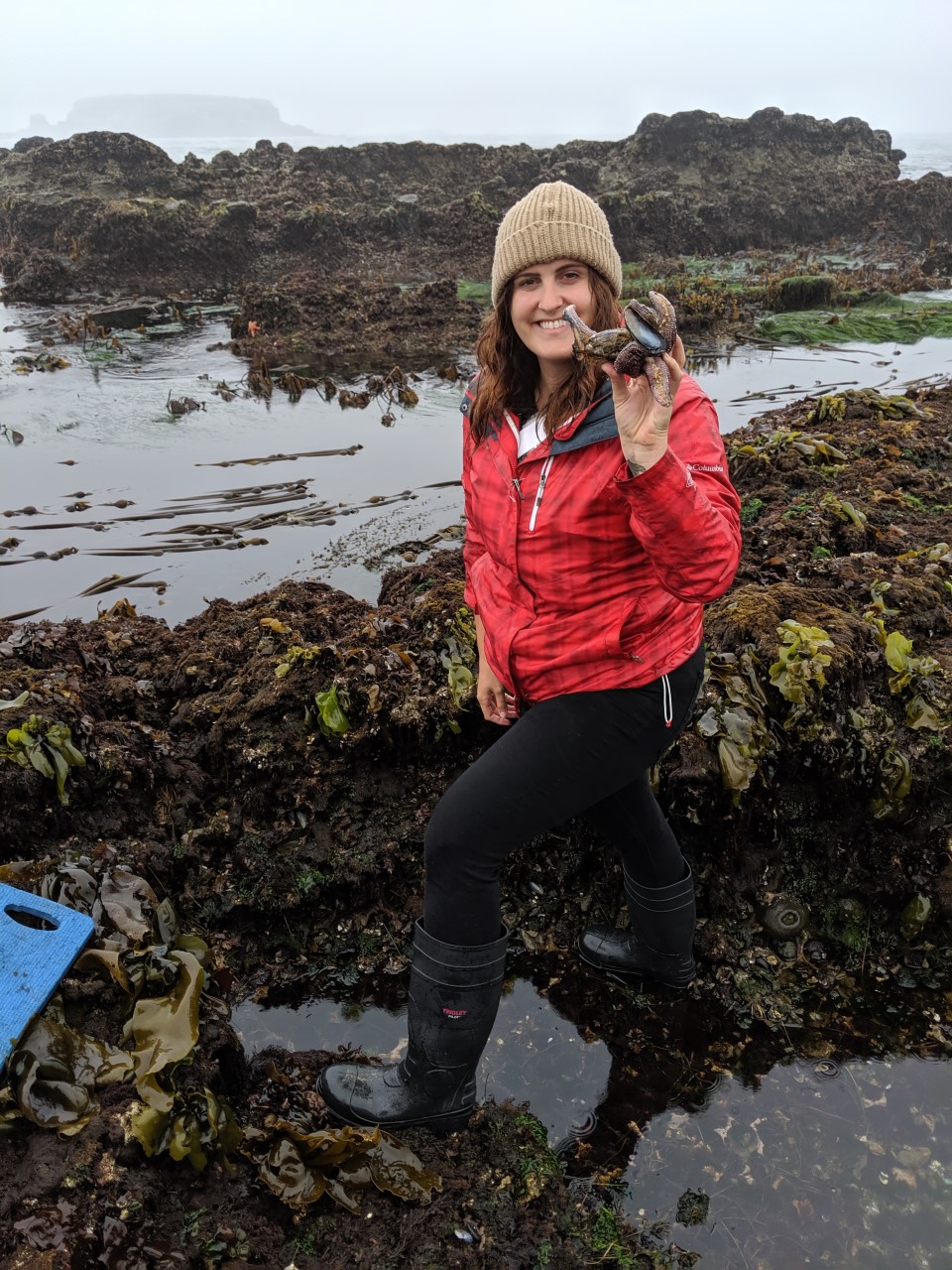
Research
Despite the ecological importance of mesopelagic animal communities, little is known about their ecology. The hammerjaw (Omosudis lowii) is a mesopelagic fish found in temperate and tropical waters worldwide, including the Gulf of Mexico. Hammerjaws have distensible jaws and stomachs, allowing them to capture extremely large prey relative to their body size. They are severely understudied but are often observed with squids in their stomachs. To date, no scientific study has been done to determine their feeding patterns. To fill this knowledge gap, I will conduct a stomach content analysis (SCA) study using preserved hammerjaw specimens collected by Gulf of Mexico research cruises from 2011 to 2021. Using various statistical methods, I will combine the SCA findings with life stage, environmental, spatial, and temporal data to provide a better understanding of the distribution and feeding ecology of Gulf of Mexico hammerjaws throughout their lifecycles. Ultimately, my research will describe diet as a function of ecology and set a baseline for further research on hammerjaws and mesopelagic trophic interactions.
Claire de Noyo, Graduate Student
Hi, I’m Claire and I’m a first-year master’s student in the USFSP conservation bio program! I’ve always had a passion for all things marine but my path to grad school has certainly not been a traditional one. I went back to college in my late twenties after dropping out of film school (I wanted to be a documentary filmmaker/save the whales!) the first time around. After dabbling in various majors at community college, I realized my aptitude for science, transferred to Oregon State University, and committed to marine biology. Right before my final year at OSU, I had an amazing opportunity to spend the summer at the Hatfield Marine Science Center, a marine research hub on the Oregon coast. My time at Hatfield truly changed my life so I set my sights on grad school and the rest is history! I’m beyond excited to be here at the Judkins Invertebrate Lab and can’t wait to get started on my thesis research.
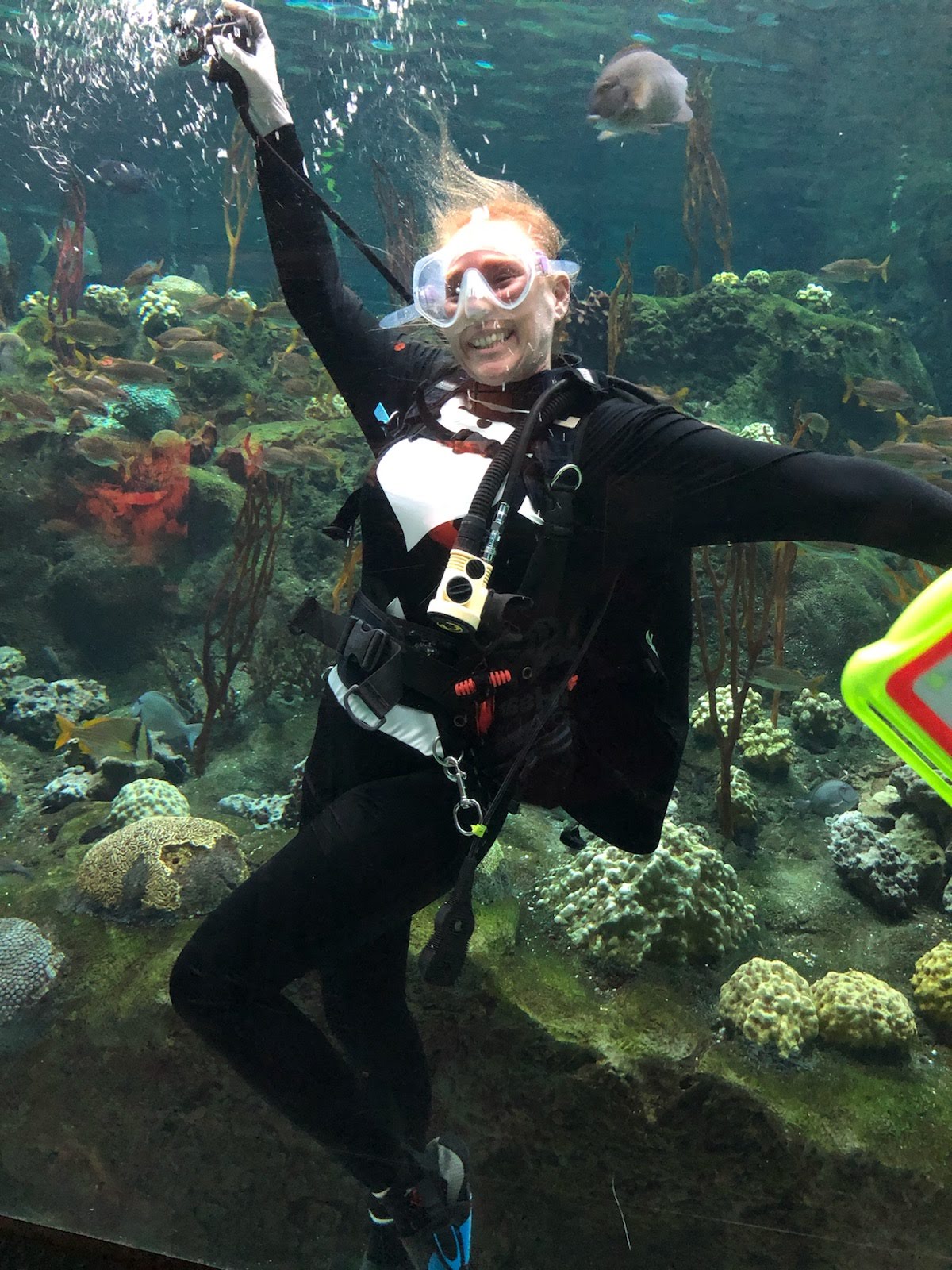
Research
Chemical compounds related to oil spills such as polycyclic aromatic hydrocarbons (PAHs) and persistent organic pollutants (POPs) like pesticides such as DDT can accumulate and persist for long periods of time in the Gulf of Mexico. Exposure to these organic compounds can be harmful to organisms and humans. They can also bioaccumulate in higher trophic levels within the ecosystem. And since squid are a prey item for many species it’s important to discover to what level chemical compounds may or may not contribute to bioaccumulation in their consumers. The focus of my research is to investigate this question through the predator/prey relationship between squid and tuna in the Gulf of Mexico. I will identify and quantify PAH and POP levels in mid-water cephalopods (squid) and tuna from the Gulf of Mexico. Tissue samples of squid collected from research cruises as well as those found within the stomach contents of tunas and the tunas they were found in will be used for this study. Additionally, I hope to assist in the development of a method to identify toxic compounds related to microplastics in the tissues of these animals. My research will contribute to baseline data for selected cephalopod species in the region.
Lisa Rose-Mann, Graduate Student
Hi! My name is Lisa Rose-Mann, and I am currently enrolled as a Master’s student in the University of South Florida’s College of Marine Science. I’ve always loved the ocean and was fortunate to have grown up in Florida surrounded by the sea with Sea World just an hour away. My path was a little different than most and you could say that I’m a non-traditional student. My college track didn’t start until my 40’s where I earned my Bachelor’s Degree in Biology and a Minor Degree in Chemistry with a concentration in Marine Biology as an Honor’s student from the University of South Florida St. Petersburg. I was not entirely sure where I wanted to focus when I started, but my mind was made up once I met Dr. Heather Judkins. I enrolled in as many of her courses as I could, and I had the best experience working on my honor’s thesis in the Judkins Invertebrate Lab. I’m excited to once again be working with her, Dr. Steve Murawski and Dr. Isabel Romero combining biology and chemistry to study mid-water squid and tuna in the Gulf of Mexico. I’m looking for evidence of organic compounds such as those from oil spills, pesticides and potentially microplastics.
GRADUATED STUDENTS
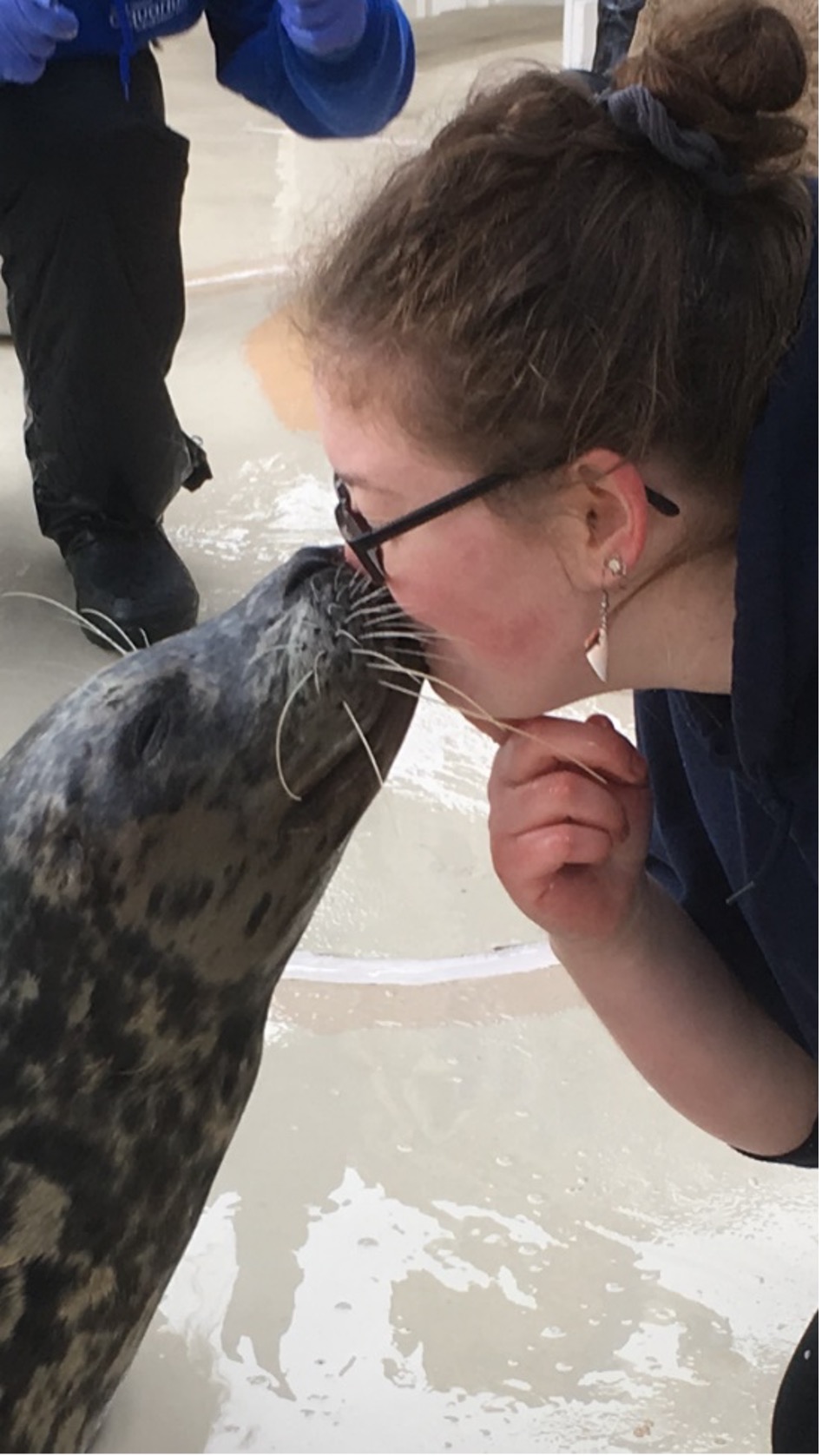
Research
My project is focused on understanding the driving factors of benthic invertebrate biodiversity patterns on urban structures around Tampa Bay. I am interested in filling in the gaps in knowledge surrounding urban marine communities and the interface between humans and nature.
Cassidy Bell, Graduate Student
Hey everyone, I’m Cassidy! I am currently pursuing my Master’s in Conservation Biology as a member of Dr. Heather Judkin’s lab. I graduated with my BS in Marine Vertebrate Biology from Stony Brook University in 2020. I have been involved in a number of research projects related to population and spatial ecology and have worked in a variety of educational settings from elementary schools to universities.
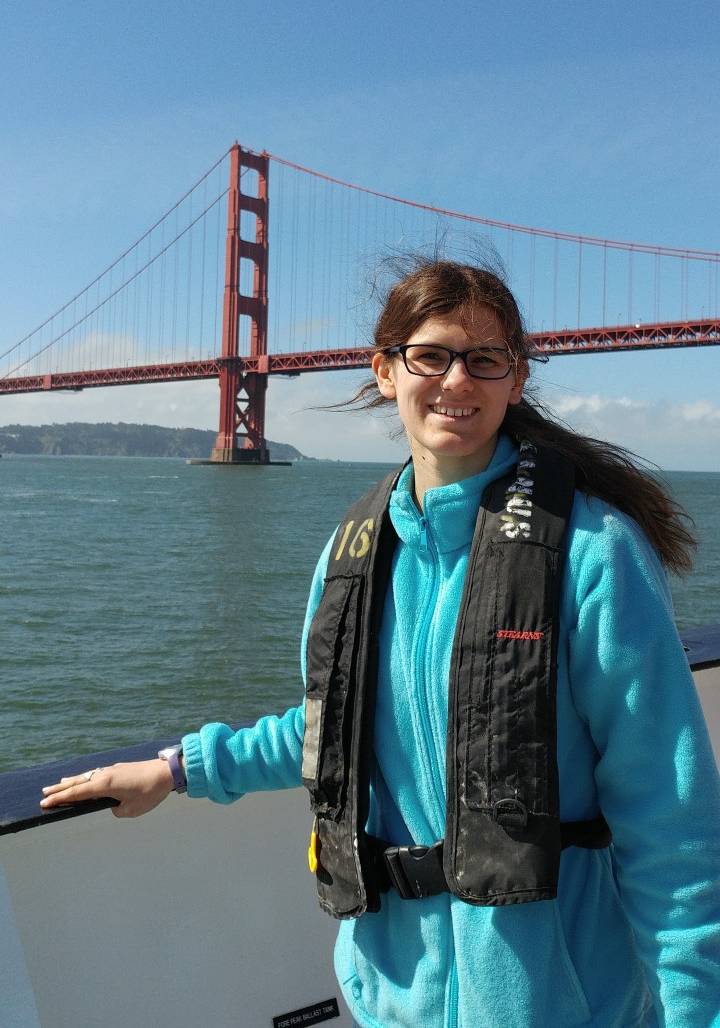
Research
For my thesis research, I will be studying the post-hatching life stages of cephalopods (paralarval and juvenile) in the Gulf of Mexico. I’ll identify specimens collected by the Southeast Area Monitoring and Assessment Program, then conduct statistical analysis to examine their distribution and how environmental factors affect their abundance. To analyze vertical distribution, I’ll split the paralarvae into groups based on the depth at which they were collected and use multidimensional scaling to test for the presence of unique species assemblages. I’ll repeat this process with the latitudinal collection locations to examine any differences between shelf and offshore species assemblages. The second portion of my research will use stepwise regression to determine which environmental factors have the greatest impact on paralarval abundance. For both aspects, I’ll also be calculating measures of biodiversity such as the Shannon-Weiner diversity index.
Shannon Riley, Graduate Student
My name is Shannon Riley and I’m a Master’s student in the University of South Florida College of Marine Science. I was drawn to cephalopods after seeing videos of them on National Geographic TV shows and then finding juvenile specimens in plankton samplToggle Sectiones. I graduated from Oregon State University in 2019 with degrees in ocean science and marine biology. I discovered Dr. Judkins’ research while exploring ideas for graduate school research and decided head across the country to join her lab at USFSP. I will be working with Dr. Heather Judkins and Dr. Steve Murawski to examine the distributions of cephalopod paralarvae in the Gulf of Mexico and analyze which environmental factors affect their abundance.
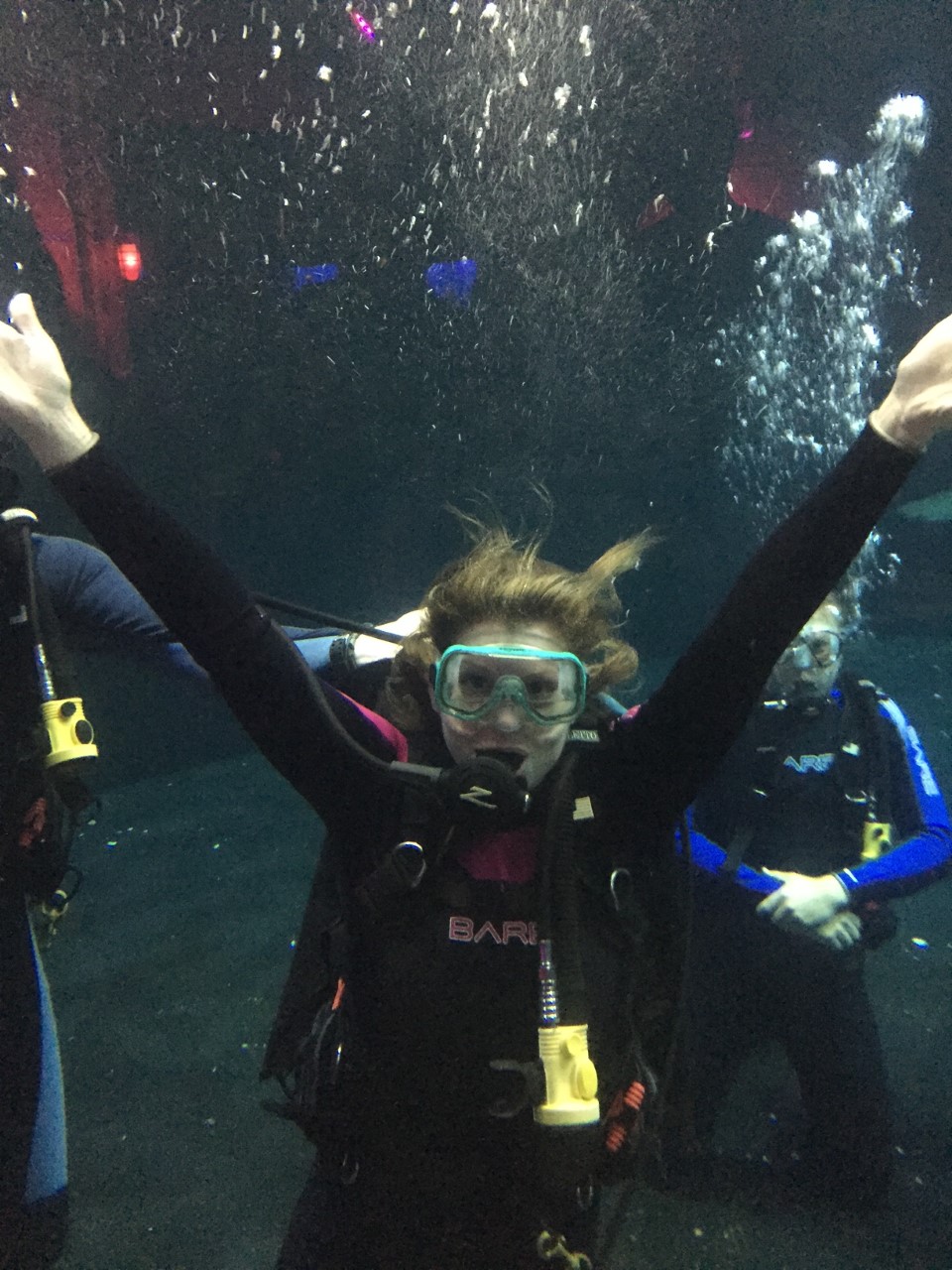
Research
Toggle Section
Research
My master’s research will focus on Eastern oysters (Crassostrea virginica). I plan
to collect samples from various coastal areas around Tampa Bay, particularly those
that may see heavier boat traffic, bringing in more debris and theoretically more
pollutants. I want to examine the amount of microplastics found in these animals and
measure the overall water quality of the area (temperature, salinity, dissolved oxygen,
nitrogen, turbidity, pH, etc.) I would also like to gather samples both in the summer
and winter to compare seasonality. I would like to compare my findings to similar
coastal areas with less traffic to see if there is a difference in micro-pollutants
and overall water quality.
Andrea (Andie) Murray, Graduate Student
My name is Andie, and I graduated from The Ohio State University with a BS in Zoology in 2015, and have been working at The Florida Aquarium ever since. The stars aligned, and I decided it was time to get myself back in school. I have known Dr. Heather Judkins since I started at the aquarium where I truly fell in love with conservation education. I am part of organizations such as the Association of Zoos and Aquariums (AZA), National Marine ELorem ipsum dolor sit amet, consectetur adipiscing elit. Morbi facilisis condimentum semper. Mauris sem erat, viverra id nunc non, ornare fermentum odio. Duis convallis elit vitae eros convallis congue.
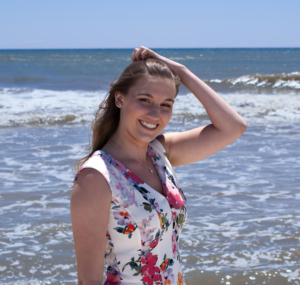
Research
My master’s research is focused on studying the movement of the coastal fisheries squid Doryteuthis pealeii in the eastern Gulf of Mexico throughout its lifespan. I hope to be able to better define the migration patterns of this species through analysis of the carbon and nitrogen isotopes in its eye lenses. These isotopes are deposited within thin, concentric layers of crystallin proteins around the outside of the eye lenses as the squid ages. δ13C isotope ratios tend to show a correlation with depth and supporting primary producers, while δ15N isotope ratios can show a correlation with distance from the coast due to the type of nitrogen source to the food source. I also hope to be able to determine the ages of D. pealeii specimens through examination of their statoliths. Statoliths are small, hard components of the statocyst within cephalopods that form growth increments throughout the specimen’s lifetime. By comparing the age of each specimen to the number of eye lens layers they have, I will be able to determine how often this species deposits a new eye lens layer. The joint analysis of stable isotopes within each eye lens layer and the age of each specimen should allow me to analyze the migration patterns of D. pealeii throughout different stages in its life.
Hannah Schwaiger, Graduate Student
My name is Hannah Schwaiger and I’m a Master’s student in the University of South Florida’s College of Marine Science. I fell in love with cephalopods through hearing stories about them in classes during my undergraduate degree in marine biology at the University of West Florida. I learned about USFSP while taking the Florida Institute of Oceanography’s Marine Field Studies Course, during which I spent a week learning about the open ocean from Dr. Judkins. I had the opportunity to identify the only squid we caught on our research cruise that week, and I have had a love for USFSP ever since. I will be working with Dr. Heather Judkins and Dr. Ernst Peebles on stable isotopes in the eye lenses of Doryteuthis pealeii, a species of inshore squid, and will use this data to map the locations of the squid throughout the Gulf of Mexico during different times in their lives.
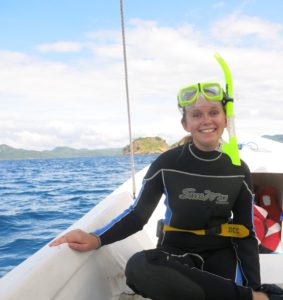
Research
The purpose of my Master’s research is to compare the behavior of sea turtles in captivity. I am collaborating with aquariums in Florida to determine how species type, health condition, size of enclosure, length of rehabilitation, and time of day affect how turtles behave. The tool required for this type of study is an ethogram, which is a list of behaviors seen in an animal with detailed descriptions. My ethogram includes general states of the sea turtles including rest, swim, respirate, groom, and aggression with more specific behaviors within the states such as rubbing on rocks, sleep, diving, surfacing, and scratching face with flipper. The turtles range from one that has been in captivity for 45 years to several very short term turtles that have only been in rehabilitation for several weeks. The goal of my project is to see how differences between turtles can affect their behavior, and how that can be applied to future sea turtle rehabilitation.
Kate Lowry, Graduate Student
Kate Lowry is a Master’s student of Conservation Biology at the University of South Florida Saint Petersburg. She is working with Dr. Judkins and the Florida Aquarium on sea turtle behavior in captivity for her thesis research. This research will compare several factors of the turtles’ environment and health in order to make conclusions about how turtle behavior varies. Her Bachelor’s degree is in Marine Biology and Conservation Biology/Ecology from Bowling Green State University in Ohio.
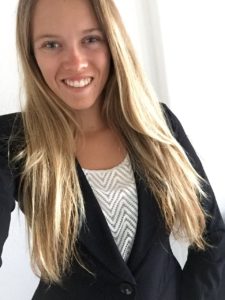
Research
In collaboration with the USF College of marine science and Texas A&M Harte Research Institute, my master’s project is researching PAH exposure on red snapper in artificial and natural reef sites found in the northwestern Gulf of Mexico. The objectives for this study are to measure and compare PAH concentrations between gender, tissues or matrices (liver, gonad, muscle, and bile samples), and habitat type (natural vs. artificial reef systems) from red snapper collected in the Gulf of Mexico. With the growing amount of oil rigs in the Gulf of Mexico, it is important to understand if these rigs are creating negative affects for surrounding marine life. Polycyclic aromatic hydrocarbons (PAHs) are environmentally persistent pollutants that are both anthropogenically and naturally derived. These pollutants are known to be associated with oil rigs with potentially negative effects due to increased exposure to the organisms that utilize these structures. Since red snappers have been known to be an important part of the fisheries due to their high abundance rate, understanding the potential affects of PAHs is important to help better manage these affects and protect the natural marine environment.
Tiffany Nicholson, Graduate Student
Hello, my name is Tiffany Nicholson. Recently I just graduated from the University of South Florida St. Petersburg in the Honors Program with a major in Biology, a minor in Environmental science, and a concentration in Marine biology. I am now a Master’s student at the same University studying conservation biology with my research being focused on marine biology and toxicology. Since I was a young girl I have always lived on the water, which has helped gain my passion for marine biology. With my master’s research I hope to understand more about the affects of oil pollution on red snappers in the Gulf of Mexico.
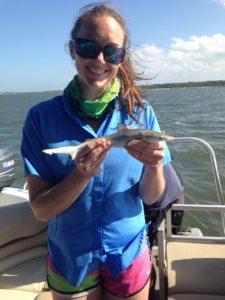
Research
My Master’s research project is focused on Pteropods (pelagic marine snails) collected from the Gulf of Mexico by the DEEPEND project. Pteropods play an important role in the food web of the pelagic ecosystem and they are a good indicator for ocean acidification. My research will provide valuable information on their identification, diel vertical migration patterns, shell thickness, distribution and abundance in the Gulf of Mexico (GoM). Pteropods are sensitive to environmental changes, such as temperature, pH and salinity, and these environmental stressors affect their ability to produce their shell. The aim of this research is to examine and understand how they are affected by these environmental stressors in the GoM.
Sarah Shedler, Graduate Student
Sarah Shedler is a Master’s student at USF’s College of Marine Science. She is working with Dr. Heather Judkins on pteropods. Her master’s thesis is focused on their identification, distribution and abundance in the Gulf of Mexico. Sarah received her Bachelor’s of Science, with a marine biology concentration from the University of South Florida St. Petersburg.

Research
In collaboration with The Florida Aquarium’s Center for Conservation (CFC), my research is focused on the microbial community makeup, and the establishment of an average growth rate for Dendrogyra cylindrus, commonly known as the pillar coral. D.cylindrusis the only species in its genus and is classified as vulnerable by the IUCN Red List. This large scleractinian coral species forms tall vertical pillars, reaching up to 3 meters if undisturbed. Coral nurseries, such as the CFC “coral ark”, are progressing conservation and restoration efforts by growing and transplanting coral fragments. By looking at the resident microbiota of multiple D.cylindrusgenotypes this study can contribute to the establishment of a core microbiome for the species to be used as a baseline to determine if bacterial clade shifts occur during restoration efforts. This will also aid future efforts for the mitigation of coral disease as well as contribute to the continued development of conservation management and reef restoration practices.
Aubrey Hetzler, Graduate Student
I am a 2014 graduate of Penn State University where I completed a Bachelor of Science degree in Animal Science with a minor in Marine Science. Prior to graduating I spent 6 months with The University of Southampton,UK, taking classes in Marine Biology and Oceanography at The National Oceanography Center. At USFSP I am part of the first group of Conservation Biology graduate students. My Master’s research will focus on the conservation of Dendrogyra cylindrus (Pillar Coral) through a microbial community assessment and growth study.
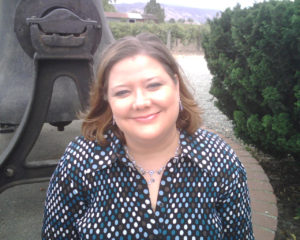
Research
As a research assistant in Dr. Heather Judkins’ lab, my efforts are focused on understand the pelagic ecosystem of the Gulf of Mexico (GoM) through the vertical migration and distribution of the highly important biomass of cephalopods and heteropod species (pelagic marine snails). Species of heteropods vertically migrate day and night from the mesopelagic (200-1000 m depth) to the epipelagic depths (0-200 m) to escape predation and feed. By considering the data collected from net catches we gain knowledge of species abundance, behavior, and impacts from the environment. These efforts will further establish means of evaluations of deep-ocean ecosystems to disturbance impacts and recovery estimations. I continue to become familiar with cephalopods of the GoM and western central Atlantic by identifying species, pulling tissue samples for genomic DNA sequencing, taking organism measurements, record photographs of specimens, and preserving samples for these and future projects.
Kris Clark, Graduate Student and Research Assistant
Kris Clark is a graduate student at USF’s College of Marine Science and DEEPEND research assistant in Dr. Heather Judkins’ lab. She plans to obtain her Master’s Degree in Biological Oceanography. Her master’s thesis is focused on pelagic marine heteropoda vertical distribution and eye diameter size correlations in the water column and examining population genetics. As a research assistant to Dr. Heather Judkins at USFSP, her role focuses on the genomic and morphological identification of various cephalopoda. Kris is a life long ocean enthusiast which compliments her work with DEEPEND and her educational pursuits.
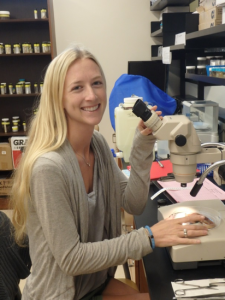
Research
My Master’s project is focused on the stable isotope analysis of squid eye lenses. The use of stable isotope analysis (SIA) can be used as a tool to identify trophic and migratory histories of animals. Stable isotope ratios of carbon and nitrogen trace pathways of organic matter among organisms. The variation of nitrogen isotopes (δ15N) is an indicator of the animals’ trophic level and prey while the variation of carbon isotopes (δ13C) can be used to identify a primary producer at the base of a food chain. More recently, eye lenses have been used as a successful means for identifying the stable isotope ratios of certain squid species. Squid lenses exhibit a layering of thin tissue. There is a chronological deposition of concentric layers to the lens as the squid ages. The center of the lens contains the oldest layer, and the youngest layers are on the outermost surface. The lens is made up of crystallin proteins, which are rich in both carbon and nitrogen, making the eye lens a suitable source for isotopic analysis of both δ15N and δ13C. The goal of my research is to identify the geographic migrations of Doryteuthis plei in the Gulf of Mexico. I plan to distinguish the migratory and spawning patterns of this species by comparing the variations of stable isotope ratios from their eye lenses.
Brenna Meath, M.S. Graduate
Hello! My name is Brenna and I am from Queensbury, New York. I grew up in the Adirondack Mountains near Lake George so I have always been passionate about nature and the environment. At a young age my family brought me on trips to the Caribbean where I first started snorkeling. I knew from then on that I wanted to be a marine biologist! I came to Florida in 2010 to get my bachelor’s degree in Marine Biology from the University of Tampa. Since graduating in 2014 I interned at MOTE Marine Lab conducting coral reef research and at NOAA conducting shark research. My master’s thesis in biological oceanography conducted research on squid eye lenses from the Gulf of Mexico to determine spawning and migratory patterns.

Research
My Master’s research is focused on intraspecies variation and population connectivity in deep-sea cephalopods, as well as linking taxonomic diagnoses with DNA barcodes. My objectives include: determining genetic diversity in deep-sea cephalopods at the species level, determining genetic connectivity in deep-sea cephalopods at the regional level across different stations in the Gulf of Mexico (GoM), and at the population level across disjunct basins (GoM and Northwest Atlantic Ocean). By studying these patterns in deep-sea cephalopods, my research will lend insights on gene flow patterns among cephalopod species in the GoM and Northwest Atlantic Ocean. It is imperative to understand the gene pool and genetic exchange of deep-sea cephalopods to determine if demographic independence exists among populations, and subsequently, assess their vulnerability to impact and recovery after disturbance.
Amanda Sosnowski, M.S. Graduate
My research interests focused on marine invertebrate biodiversity and population connectivity. For my Master’s research I worked with Dr. Heather Judkins and Dr. Mya Breitbart on a comparative genetics study of deep-sea cephalopods in the Gulf of Mexico. Dr. Judkins conducts research in cephalopod systematics, abundance, and diversity in the Gulf of Mexico, while Dr. Breitbart uses molecular techniques to assess marine biodiversity, respectively. I interacted closely with both faculty members to examine intraspecies variation and population connectivity, as well as link taxonomic diagnoses with DNA barcodes. By studying the gene pool and genetic exchange of deep-sea cephalopods, my research will lend a fuller picture to the amount of gene flow amongst cephalopod species in the Gulf of Mexico.
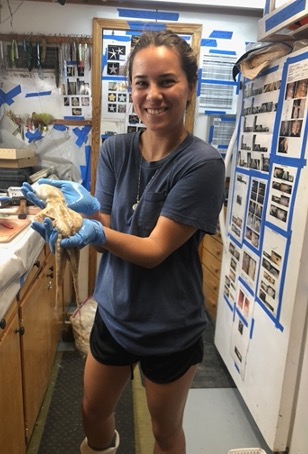
Haley Holloway
Research
The family Octopodidae has been a rather poorly understood group of organisms, with
particular taxonomic confusion within the genus Octopus. Until recently, taxonomists
have relied heavily on apparently insufficient morphological similarities to assign
a species name to an individual. This has led to widely dispersed individuals being
lumped under one species name, and to the assumption that these species are cosmopolitan
due to their vast geographic range and worldwide abundance. Advancements in technology
have made it possible for scientists to conduct molecular analyses on these problematic
groups, revealing that species once believed to be cosmopolitan are actually complexes
of multiple smaller, genetically distinct species. My Master’s research will focus
on utilizing mitochondrial markers (COI & 16S) to determine if Octopus joubini represents
a complex in the eastern Gulf of Mexico. This research will include the first molecular
analyses of the Octopus joubini complex in hopes to aid in solving this taxonomic
problem.